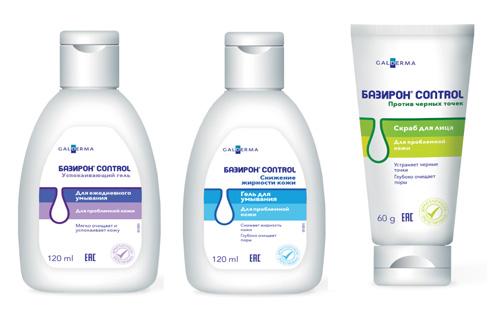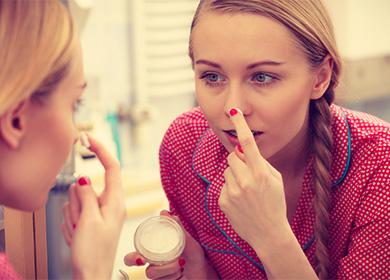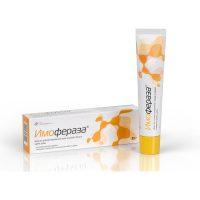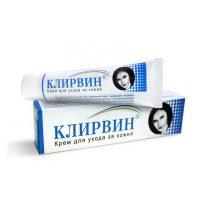The content of the article
Single comedones (black or white fat “plugs”) and acne (inflammation of the gland under these “plugs”) are not pathologies. Usually they arise as a result of poor hygiene or accidental blockage of the duct of the sebaceous gland with dead layers of the epidermis. Dermatologists talk about the disease only if acne "invades" certain areas of the face or body on an ongoing basis, possibly with periodic remissions. Comedones and blackheads at various stages of “flowering” are called acne.
The origins of the problem
The problem of "malicious" acne in some representatives of both sexes was not discovered yesterday, but science to this day cannot establish all the causes of this phenomenon. The following factors appear in the already known part of the list.
- Hormones. Conflicts and changes in the background, especially common in women. This is the natural cycle, pregnancy and other periods of life. In men, the background is more stable, but it “inclines” the sebaceous glands to active work more noticeably, which can also contribute to rashes.
- Infections They are not always third-party, often associated with an imbalance of skin microflora.
- Gastrointestinal pathology. They affect the speed, degree of assimilation of food components and the quality of the breakdown of fats from it. The abundance of fat in consumed foods itself accelerates the work of the sebaceous glands. And with metabolic disorders due to diseases of the intestines, liver or gall bladder, the situation tends to get out of control.
- Irritation by chemicals. Harmful substances are contained not only in personal hygiene and care products, but also in the environment. Comedogenic are the evaporation of chlorine, compounds of lithium and bromine. Cheap creams for face and tonal bases on synthetic fat have the same properties.
- Taking medication. Barbiturates, steroids, antibiotics are capable of total destruction of the microflora of the skin, which "opens the gate" to other pathogens.
- Genetic predisposition. It is associated with the special structure of the sebaceous ducts (too narrow or winding) and other structural deviations.
Low hygiene can play a significant role in the development of acne. Sebum has a viscous texture and slightly acidic balance. It serves as a means of protecting the epidermis and pores from the penetration of pathogens, since it is able to block their movement and reproduction even “on the approaches”. But its antiseptic properties do not last long - no more than three days. Most bacteria and fungi can turn an acidic environment unfavorable for them into a comfortable alkaline environment during their life.
What is post-acne
As a result of suppuration of individual pores, more or less deep “potholes” appear on the skin - depressions that make the affected time noticeable even from afar. If the process affects the subcutaneous tissue, a deep “hole” or a wide “crater” can form in the skin.
Over the years, inflammations last longer and longer, leaving not only a new “relief” in place of the already opened blackheads, but also reddish spots. Even with their regular removal, comedones give slightly smaller pore openings than acne, but they are still clearly stretched. Layering and merging, these defects turn the face into a real "moon landscape". If the process continues, new ones appear along with traces of past inflammations. This is due to two multidirectional processes that the skin starts in response to infection with all its inherent features (development speed, depth, scale of damage to the sebaceous gland, its duct).
- Atrophy. “Craters” and other indentations in or under the skin are called atrophic.
- Hypertrophy. So called whitish protruding scars, often located along the edges of the recesses (combination with atrophy). They are called keloid and differ from the usual ones in the stiffness of the structure and the ability to grow in width over time. The tendency of the skin to form keloids is inherited instead of the usual scars. The likelihood of their occurrence increases if the inflammation spreads to the lower layers of the dermis and subcutaneous fat.
Treatment options
The best results when aligning problem skin gives hardware cosmetology. But it has its side effects in the form of accelerated skin aging a few years after the end of the course of procedures, as well as the likelihood of defects of another type - age spots, vascular "mesh" (rosacea), neoplasms, including malignant. Such exposure is prohibited:
- with existing skin cancer;
- ongoing rashes;
- infections of any localization in the acute stage;
- venereal pathologies.
Long-term use of absorbable ointments against scars and acne scars is always implied - from six months or longer. Only darsonval can give a faster result in theory, or darsonvalization is a physiotherapeutic method of stimulating blood circulation and metabolism in target tissues under the action of a current of low strength and high frequency.
This method is not new and has been widely used in the USSR, but its effectiveness has not been convincingly proved. Fans of darsonvalization note its positive effect on local blood circulation, blood pressure, a short-term increase in its elasticity of the skin. Skeptics point to the weakness and instability of the results, the absence of long-term effects, even with regular and long-term use.

Composition of pharmaceutical products
When creating a cream or ointment for resorption of scars and scars on the face after acne, pharmaceutics usually focuses on discoveries in this area made by the healers of antiquity. Almost mandatory components in their composition are as follows.
- Bleach. Both zinc oxide and other metals, and organic acids - salicylic, boric, ascorbic, etc. They lighten the skin, eliminating redness and yellowness, which often manifests with age. The discovery of the antiseptic, antioxidant and whitening properties of food acids is the merit of traditional medicine, which once discovered them in masks made of fermented milk products and sour fruits. Similarly, in the past, whitewash was also applied to the face, simply without distinguishing the effects of whitening the skin with neutral zinc oxides and extremely toxic lead.
- Softeners. Usually in a cream or ointment from post-acne on the face, they are represented by natural fats of animal or vegetable origin. The first absorbs the skin more readily than the second, because they provide it with a deeper nutrition and better protect against the growth of keloids, if any. But the vegetable oil remaining on it in the form of a film protects the damaged epidermis from repeated penetration of pathogens and contact with irritants from the outside.
- Other nutrients. The epidermis, like any other tissue, needs some components more than others. Critical cholesterol remains for it (softens the hard protective membranes of the horn cells and allows them to be updated in a timely manner), proteins (especially collagen and elastin), vitamins A and E. In the list above, the skin surface is able to absorb one cholesterol, and then in a limited amount. Everything else should be taken only inside or injected into its deeper layers. And their presence in conventional cosmetic or healing creams for scars and scars is nothing more than a commercial move that does not affect the effectiveness of the drug.
- Antibiotics and anti-inflammatory. They are relevant in the treatment of not post-acne, but "fresh" rashes. The fact that the use of pharmacy potent antibiotics cannot last more than a month is generally recognized. They destroy the beneficial microflora along with the harmful, further reducing local immunity. Therefore, for long-term therapy, plant extracts with a similar, only milder effect are usually used instead. Usually these are plants with a high content of tannins and alkaloids - products of plant metabolism and natural toxins, poisonous not only to humans, but also insects, herbivores, fungi. Plants synthesize them for the purpose of self-defense, and their local application gives a slight analgesic, disinfecting, whitening effect. Sulfur has the properties of an antiseptic and a stimulator of local blood circulation, which also dries up inflammation, is also a frequent “guest” in the composition of creams and masks for problem skin.
- Anticoagulants. Their superficial or oral use without extreme need is not recommended because in the presence of blood clots in the vessels, they can provoke their separation from the wall and into the bloodstream. And even if there are none, the abuse of clotting-reducing drugs leads to rosacea, especially with problem skin that is prone to it. But their use to eliminate epidermal defects improves its blood supply and regeneration of damaged areas, prevents their coarsening and the growth of keloid scars.
Creams, gels, methyluracil ointment for scars and facial scars: an overview
Indications for the use of preparations for smoothing the skin often relate to the fight not only with post-acne, but with large scars remaining after operations and injuries. Some of them were generally developed for other purposes, and the presence of smoothing properties was discovered later. Among the synthetic preparations developed to combat scarring, the following can be distinguished.
Contractubex
German gel against acne scars and scars and more. The light gel texture and the absence of fat softening agents have made Kontraktubeks popular because it is most convenient for applying to the skin of the face instead of the usual means for caring for it. In the composition of the gel:
- onion extract - antiseptic and stimulator of local blood flow;
- heparin - direct anticoagulant;
- allantoin - a product of the breakdown of uric acid with a softening epidermis and stimulating the regeneration of endoderm action.
Dermatics
Just a silicone gel that doesn't contain anything else. “Dermatics” is hypoallergenic and dense, creates a film on the surface of the scars, which protects them from contact with the environment. It is assumed that this allows you to slow down or even prevent coarsening of the scar tissue, and hence its proliferation. Silicone also has a slight emollient effect on the stratum corneum. Its main drawback is the disappearance of all effects immediately after washing off.
"Imoferase"
Another single drug based on hyaluronidase. Hyaluronic acid is an element of extracellular structures that is widely known in cosmetology - those that unite cells into tissue. Depletion of hyaloronic acid forms the basis of aging of the entire tissue to a much greater extent than problems with cell division. Hyaluronidase is an enzyme that destroys hyaluronic acid and prevents the formation of scars (it "sticks together" layers and skin cells together, and the antagonist enzyme destroys it, stopping scarring). The use of "Imoferase" can slow the healing of fresh wounds, but is considered to be an effective remedy against the coarsening and "spreading" of the formed defects. Hyaluronidase also increases the overall permeability of tissues to other applied drugs, ultraviolet.
"Methyluracil"
The main active substance of the ointment is indicated in its name. "Methyluracil" is a cell division stimulant that acts directly at the site of application (in the gastrointestinal tract - with oral administration of tablets), and indirectly - on bone marrow activity in the production of red blood cells, white blood cells. It is considered an immunostimulant and anti-inflammatory agent due to the acceleration of leukocyte synthesis, reduces the effect of photoaging of the skin at the places of application. Contraindications to the use of "Methyluracil" are bone marrow, blood or skin cancer.
Solcoseryl
Or Actovegin. Both drugs are based on a presumably biologically active extract from the blood and tissues of calves. The effectiveness of the drug, as well as its side effects, have not been proven. In Western Europe and the USA, the use of this tool is illegal. "Solcoseryl" is prescribed for inflammatory diseases of the eye, and "Actovegin" is intended for injection - intramuscularly, into an artery or vein.
Solkoseril ointment is applied against acne scars and scars because, according to the manufacturers, it activates local blood circulation and improves the metabolism of phosphorus and its metabolites in the body.
Despite the lack of authoritative studies of efficacy, in 2001 the drug became a participant in the Olympic doping scandal with cyclist L. Armstrong and entered the list of banned ones. Indirectly, this fact indicates that he has the properties of a stimulator of muscle activity or the circulatory system, although it is not directly calculated for scar treatment, and it hardly has a significant effect on this type of tissue.
Levomekol
The combined drug based on the above methyluracil and chloramphenicol (chloramphenicol) is a broad-spectrum antibiotic. The main disadvantage of chloramphenicol is that it is old by medical standards - it has been widely used for more than 30 years. This means that most pathogens already have strong immunity to it. But many still continue to use Levomekol.
Curiosin
It consists of hyaluronic acid and a neutral zinc bleach. Curiosin is more suitable for acne than post-acne. It has a mild antibacterial effect, drying out existing inflammations, but also whitens the skin, eliminating defects in its color. Hyaluronic acid stimulates the regeneration of the epidermis. "Curiosin" is the exact opposite of "Imoferase", their consecutive or, especially, simultaneous use is unacceptable.
Zinc ointment
Or its zinc-salicylic variant. Zinc is only a relatively safe bleach for the body with a drying, astringent, antibacterial effect. There is evidence that its accumulation accelerates skin aging, but they are not strict. Basically, she treats dermatitis of various etiologies, is used as an adjuvant for suppuration of scratches and light burns. If there is salicylic acid in the composition of zinc ointment, it is also an antiseptic and anti-inflammatory, which makes it a good way to fight acne. Against the "potholes" that they leave behind, zinc-based products do not help.
Heparin ointment
In addition to the remedies already indicated, patients often try to use heparin ointment to even out the skin - based on heparin, a blood protein responsible for the resorption of existing blood clots. He acts as an antagonist of fibrinogen - the foundation of any blood clot.
Other means
Under them, it is not always worth understanding the recipes of only domestic healers - the range of modern pharmacies also contains drugs developed and manufactured in other countries of the world, often based on exotic plants. Their effectiveness is rarely higher than the synthetic products listed above, but if it is lower than theirs, then not by much. The following, though not always well-deserved fame in the treatment of post-acne was achieved.
Badiag powder
This is a freshwater sponge. Tramp - one of the least useful and most dangerous in any attempt to treat them with post-acne. To put on the face an extract of chaga (birch mushroom), sold in a pharmacy under the trade name "Befungin", is a much more reasonable idea. Badyaga in folk medicine is used after drying, grinding into powder and dilution before use with water to the state of gruel. But its "skeleton" is formed by silicon dioxide - insoluble, refractory and coarse, forming a lot of microscopic needles when grinding. This means that the powder of badiaga, extremely poor in nutrients, is a scrub, and not the most sparing one.
Rubbing them with any areas of the skin temporarily improves blood circulation due to mechanical irritation. Peeling healthy facial skin with it is not recommended because there are many much milder products that do not give such severe irritation. Rubbing them already inflamed skin is contraindicated. Redness from this will only increase, swelling - too, there will be a risk of infection spreading from the purulent foci present at the time of the procedure to the surrounding pores.
"Melt Cream"
This is an American development containing:
- allantoin;
- vitamins C, E;
- beta-carotene (a precursor of vitamin A);
- sulfur (antiseptic, blood flow stimulator);
- salicylic acid.
In addition to them, the product contains two types of vegetable oils (tea tree and blackcurrant seeds) and immunostimulants (extracts calendula and ginseng). With such a diverse composition, the cream is dangerous for people with sensitive skin or suffering from any autoimmune diseases, starting with urticaria. But it provides the skin with nourishment and protection from contact with surrounding irritants, reduces existing inflammations, eliminates the remnants of those already gone.
Clearwin
Indian drug based on Ayurvedic herbs. Their names are unpronounceable, little is known about their composition or properties to persons not initiated into the secrets of Ayurveda, since there is no experience of their use by domestic healers. Sometimes therapy with the addition of exotic plants is justified by their "novelty" - including for the body of a patient living in a different climatic zone. But the risk of an acute allergic reaction in such cases is higher than ever. And to objectively verify the effectiveness of exotic herbs is even more difficult than local ones.
Among the indications for the use of "Clearwin", treatment for post-acne does not appear, and reviews of its use for this purpose do not contain indications of any particular effectiveness. It moisturizes well, softens and nourishes, but the abundance of vegetable oils makes it unsuitable for use with oily and problematic skin due to the threat of new comedones.
Boro Plus
Boro Plus is another Ayurvedic blend. We are talking about the common name of two creams with the same composition, but different packaging color (green and purple) and texture density.
Violet cream is richer and worse absorbed, the specific aroma inherent in both of them is more pronounced. The green option is lighter in every way. The presence in its composition of relatively long-known in Europe aloe faith, basil, sandalwood and turmeric suggest that he has a slight anti-inflammatory effect. There are no other reliable data on the results of its use, as in the case of Clearwin.
What else to look for
Oily and problem skin are similar, but not identical. Usually oily skin shows most of the symptoms of a problem, and vice versa. But this does not always happen. The remedy for scars and scars on the face should be suitable for the type of patient's skin in terms of fat content and comedogenicity, since it will have to be used after each wash and for several months. Such conditions of use are quite enough to increase the number of comedones and blackheads instead of reducing them, especially since preparations to eliminate their traces often contain dense fats - a component that softens the epidermis well and creates a false impression of its alignment.
Reviews
The usual powder from the pharmacy saved my cheeks from this misfortune with the help of a badyagi, as the doctor-cosmetologist, of the “old” school, did to me. A very tough method, the skin just sheds, the spots lighten, then pass completely. It was about 9 years ago, now there are probably more modern methods.
MissAlex https://kosmetista.ru/blog/uhodovaya-kosmetika/58545.html
My girlfriend got rid of stagnant spots only after two courses of peeling. And I have a worse problem - scars (craters) after acne. I also heard from cosmetologists that it is completely impossible to get rid of them, if only with a laser, but gradually and slowly, in short, a lot of years and money will be spent on treatment. I was also offered to fill the scars with fillers, I probably will, but this does not solve the problem, but only disguises (
Kristia http://www.woman.ru/beauty/face/thread/4241873/
The effect after using Solcoseryl pleasantly pleases me. The cosmetic bag has ointment and gel. I apply ointment as a nourishing cream on the entire face and 2 times a week - on the area around the eyes. It seems to me that the skin becomes more elastic, even slightly whitened. Inflamed pimples become less noticeable and quickly disappear. But my friend Solcoseryl did not fit at all - her whole face was covered with a rash and itchy. So everything is very individual!
Angela http://ladycleo.ru/problemyi-kozhi/pryishhi/solkoseril.html







